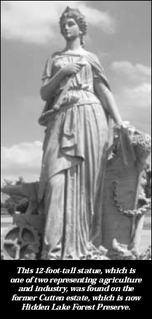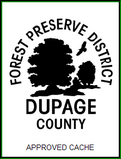During the mid 1800's settler's found their
way to this area and began to set down roots. Perus and Electra
Barney owned the land now called, Hidden Lake
Forest Preserve. Records indicate that the area included a
sawmill, post office, general store, schoolhouse, creamery and
general store. Remnants of a millrace were discovered in an
archaeological dig in 1987; however no traces of the mill were
found.
Stretching in a line through this
"patchwork" piece of forest is a stand of beautiful Osage (O-Say-G) Orange Trees. When exactly they were planted is not known yet the most
likely scenario is during the first part of the 19th century when
the land was owned by Arthur Cutten; one of the richest men in
America, until the stock market crash of 1929. These beautiful,
stately trees take their name from the Osage Native American Tribe.
They are not native to this area but were planted regularly to form
living fences and boundaries between farms. The forest has
overgrown around them but one can imagine how they made a "stately"
entrance to the grounds of Arthur Cutten. The clearing, just to the
east, held several residences.
 |
One of the most unusual "finds" at the
Cutten Estate, when it was purchased by the DuPage Forest Preserve
in 1977, were 2 Goddess Statues. These statues originally stood on
the second floor of the 1833 Chicago Board of Trade Building. They
represent Industry and Agriculture.
When the CBOT was demolished in 1885, to make room for a new
building, the statues "went missing"!. The statues were discovered
in 1978 by the DuPage Forest Preserve District when they purchased
the Cutten Estate and surrounding lands. The statues were moved to
the entrance of the Danada Forest Preserve.
In an effort to reclaim their heritage, The Chicago Board of
Trade and the DuPage Forest Preserve, worked to bring the Goddess
Statues back home. Since 2005, the statues can be seen at The
Chicago Board of Trade's outdoor plaza.
|
*CAUTION:Over the years several types of
materials have been used for boundary markers ~ trees, wood fencing
and barbed wire. Please use CAUTIONaround
any barbed wire.
*Due to the number of logs posting about TICKS I'm providing a link
for proper removal of TICKS from the Lyme Disease Associationwith a link to a very
good brochure. Have fun, Be Safe! USE BUG REPELLANT, wear long
pants and long sleeved shirts!

